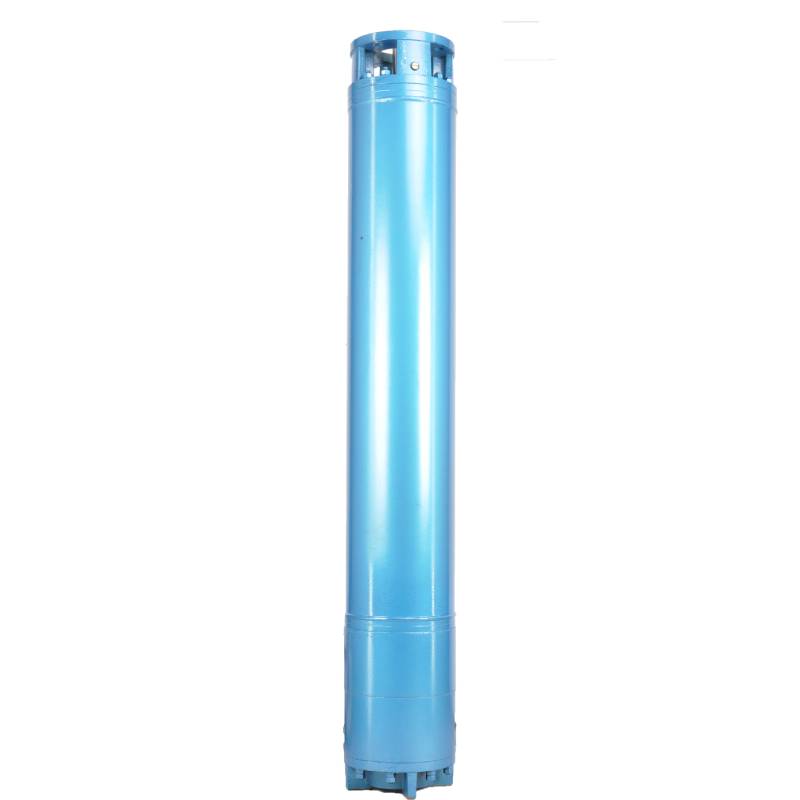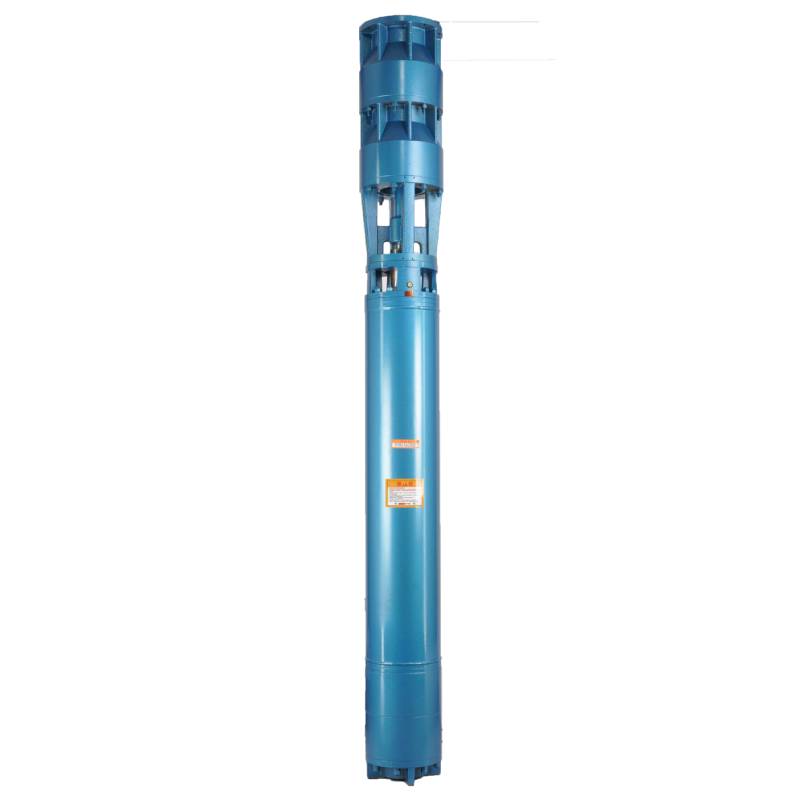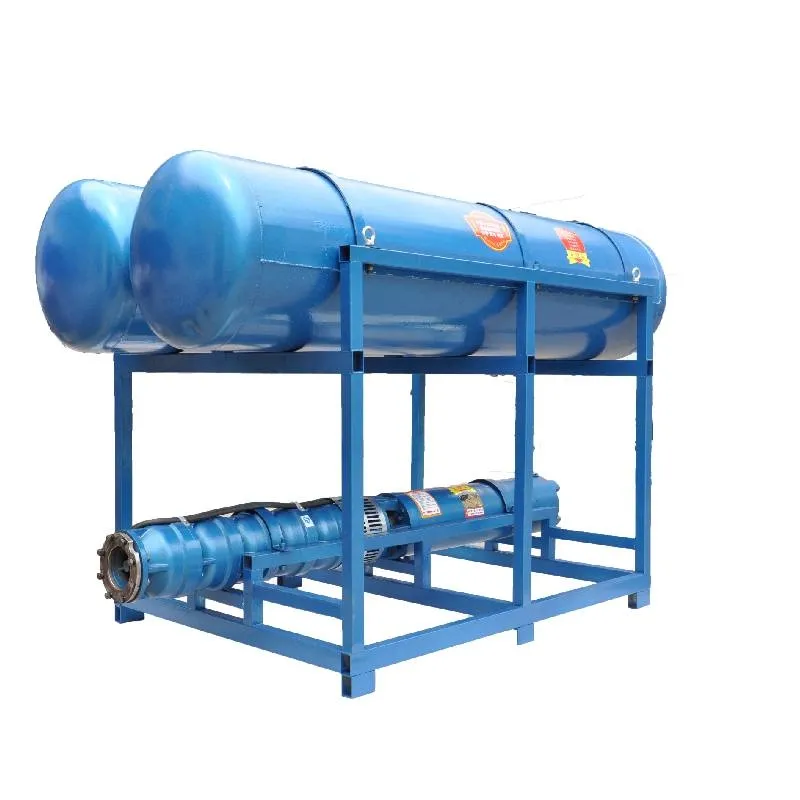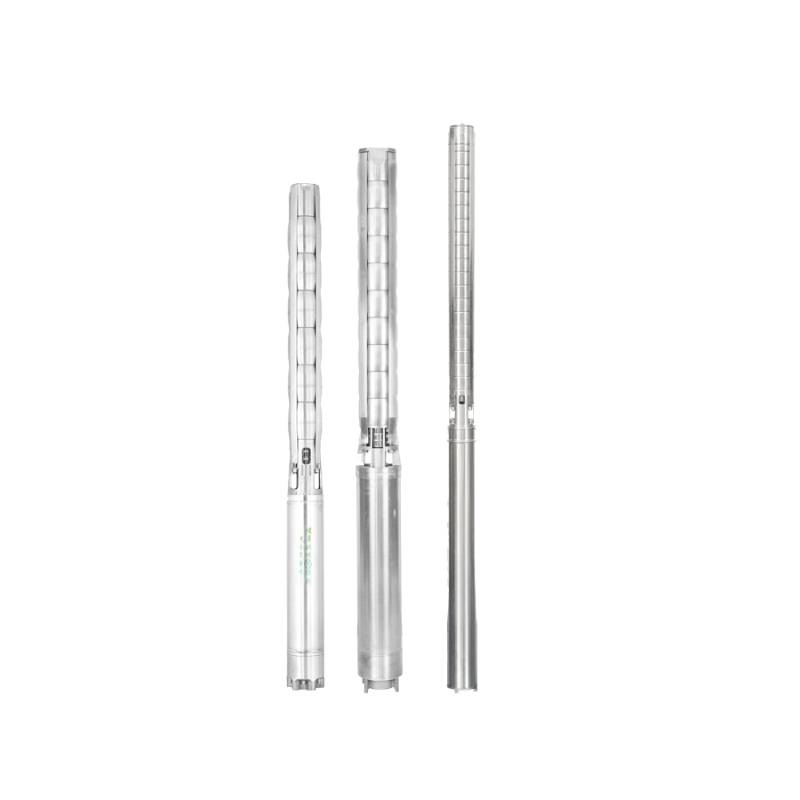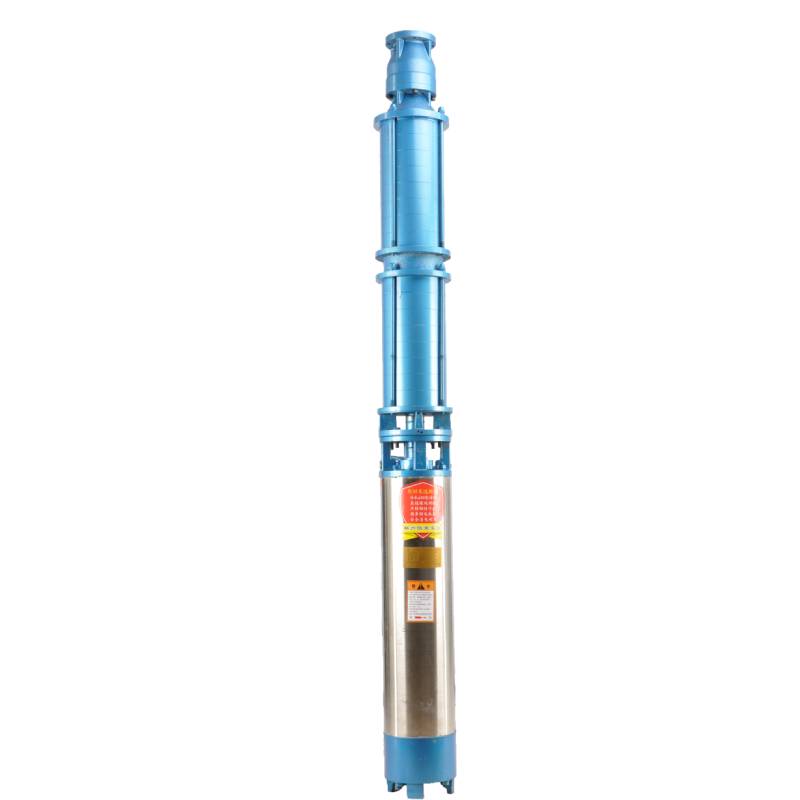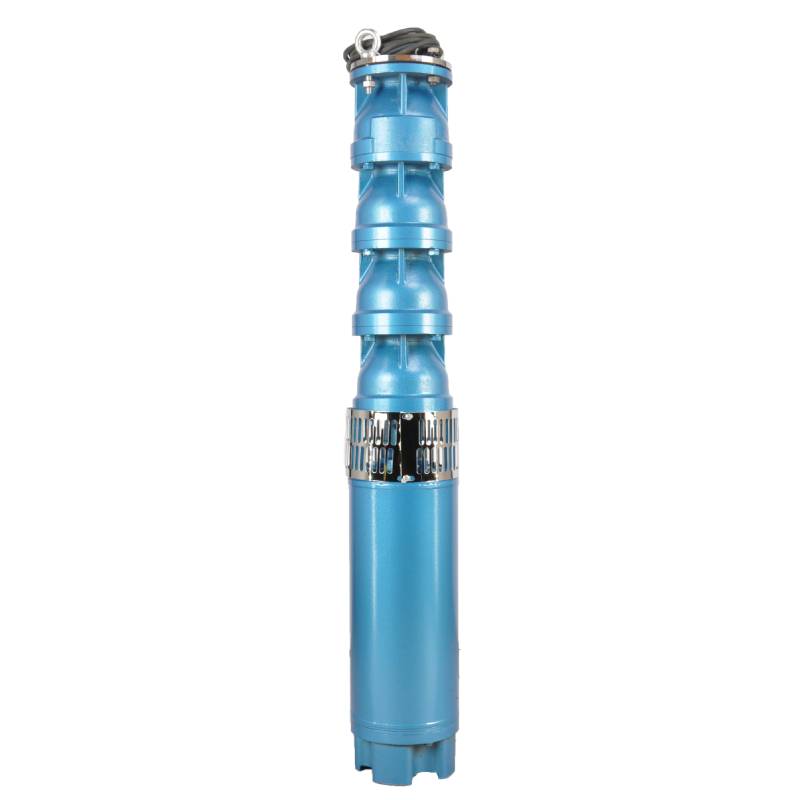This hot water pump adopts the motor made of 50W400 grade high quality cold rolled silicon steel, which is stamped by high speed punch press. It has the advantages of low stator iron loss and low self-heating. The motor winding is designed for hot water pump, high temperature resistance and anti-aging. The winding has water resistance, and adopts 3CR13 stainless steel blade shaft, high temperature resistant bushing and other high quality accessories to enable it to operate for a long time at high temperature, and can be used with frequency converter, so as to automatically adjust according to the amount of water used. This hot water pump is the ideal choice for your hot water equipment, which can operate stably and efficiently, providing you with a lasting hot water supply.
The product is a three-phase AC 380V (tolerance + / - 5%), 50HZ (tolerance + / - 1%) power supply submersible pump. With water quality requirements: water temperature is not higher than 20 °C; solid impurities content (mass ratio) is not more than 0.01%; PH value (pH) is 6.5-8.5; hydrogen sulfide content is not more than 1.5mg/L; chloride ion content is not more than 400mg/L. The electric pump adopts closed or water sealed wet structure, before use must be submersible motor inner cavity filled with clean water to prevent empty, and then tighten the water and air bolts, otherwise not to use. Its work should be completely immersed in water, immersion depth is not more than 70 meters, the distance between the bottom of the pump and the bottom of the well is not less than 3 meters. Well water inflow quantity should be able to meet the electric pump water output and continuous operation, the output water quantity should be controlled at 0.7-1.2 times of the rated flow. The well should be vertical, the electric pump can not be used horizontally or inclined, only vertically placed. The electric pump must be equipped with cables and external overload protection device as required. It is strictly prohibited to conduct no-load test under no water condition.
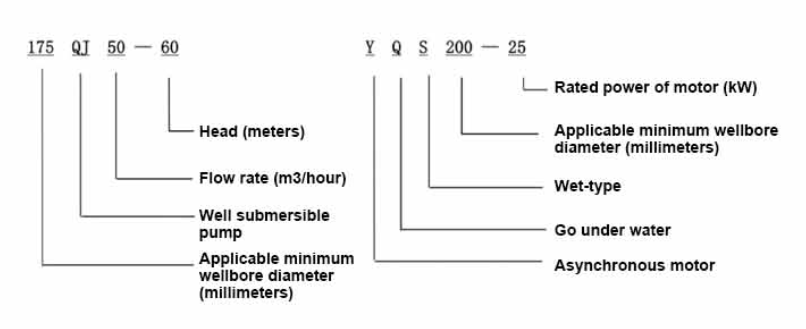
| Model | Przepływ (m3/h) | Głowa (M) |
Prędkość obrotowa (zmiana/punkt) |
Pompa wodna(%) | Wylot średnica (mm) |
Dobrze się sprawdza średnica (mm) |
Oceniono power(KW) |
Oceniono napięcie (V) |
Oceniono prąd (A) |
Sprawność motoryczna (%) | power factorcosφ | Jednostka Maksymalny rozmiar promieniowy (mm) |
Uwaga | |||||||||
| 300QJ200-40 | 200 | 40 | 2900 | 76 | 150 | 300powyżej | 37 | 380 | 77.8 | 85.0 | 0.85 | 281 | ||||||||||
| 300QJ200-60 | 60 | 55 | 115 | 85.5 | 0.85 | |||||||||||||||||
| 300QJ200-80 | 80 | 75 | 154.1 | 86.0 | 0.86 | |||||||||||||||||
| 300QJ200-100 | 100 | 90 | 183.8 | 86.5 | 0.86 | |||||||||||||||||
| 300QJ200-120 | 120 | 100 | 204.3 | 86.5 | 0.86 | |||||||||||||||||
| 300QJ200-140 | 140 | 125 | 249.5 | 87.5 | 0.87 | |||||||||||||||||
| 300QJ200-160 | 160 | 140 | 277.8 | 88.0 | 0.87 | |||||||||||||||||
| 300QJ200-180 | 180 | 160 | 317.5 | 88.0 | 0.87 | |||||||||||||||||
| 300QJ200-200 | 200 | 185 | 367.2 | 88.0 | 0.87 | |||||||||||||||||
| 300QJ200-240 | 240 | 220 | 436.6 | 88.0 | 0.87 | |||||||||||||||||
| 300QJ320-30 | 320 | 30 | 2900 | 77 | 200 | 300powyżej | 45 | 380 | 94.6 | 85.0 | 0.85 | 281 | ||||||||||
| 300QJ320-60 | 60 | 90 | 183.8 | 86.5 | 0.86 | |||||||||||||||||
| 300QJ320-90 | 90 | 125 | 249.5 | 87.5 | 0.87 | |||||||||||||||||
| 300QJ320-120 | 120 | 160 | 317.5 | 88.0 | 0.87 | |||||||||||||||||
1, well submersible pump for clean water pump, prohibit the new well, pumping sediment and muddy water,
2, well water pump voltage grade of 380/50HZ, the use of other voltage grades of submersible motors need to be customized. The underground cable must use waterproof cable, must be equipped with starting equipment, such as distribution box, start not ready should have commonly used motor comprehensive protection function, such as short circuit overload protection, phase protection, undervoltage protection, grounding protection, idling protection, in case of abnormal conditions, the protection device should be timely action trip.
3, the installation and use of the pump must be reliably grounded, prohibit the push and pull switch when the hands and feet are wet, the installation and maintenance of the pump must be cut off the power supply, the use of the pump place to set up "to prevent electric shock" obvious signs:
4, down the well or before installation, the motor cavity must be filled with distilled water or non-corrosive clean cold boiling water, tighten the / water bolt, the pump on the ground test run, must be to the pump chamber water lubrication rubber bearings, instant start not more than a second, see whether the steering is the same as the steering instructions. When the pump is upright, pay attention to safety, prevent overturning injury.
5, ściśle według przepisów dotyczących podnoszenia pompy, zakresu przepływu, aby zapobiec niskiemu lub dużemu przepływowi siły pompowania, łożysku oporowemu i innym częściom zużycia, spaleniu przeciążenia silnika
6, po odpompowaniu studni, pomiar rezystancji izolacji uziemienia silnika nie powinien być mniejszy niż 100M, po rozpoczęciu obserwacji napięcia i prądu, sprawdzić izolację uzwojenia silnika, czy jest zgodna z wymaganiami; temperatura w miejscu przechowywania pompy jest niższa niż temperatura zamarzania, należy osuszyć wodę we wnęce silnika, zapobiegać uszkodzeniu komory silnika przez lód spowodowanym niską temperaturą.
The pump part is mainly composed of pump shaft, impeller, shunt shell, rubber bearing, check valve body (optional) and other components. The motor part is mainly composed of base, pressure regulating diaphragm, thrust bearing, thrust plate, lower guide bearing seat, stator, rotor, upper guide bearing seat, sand discharging ring, water inlet section, lead cable and other components. The main characteristic of this product is that the motor is a water-cooled submersible three-phase asynchronous motor, and the motor cavity is filled with water to cool the motor and lubricate the bearing. The pressure regulating diaphragm at the bottom is used to adjust the expansion-contraction pressure difference in the body caused by the change of the temperature rise of the motor. In order to prevent the sand particles in the well water from entering the motor, two oil seals are installed at the upper end of the motor shaft extension, and a sand discharging ring is installed to form a sand discharging structure. In order to prevent the pump shaft from jumping when starting, the pump shaft and the motor shaft are connected together through a coupling, and a thrust bearing is installed at the bottom of the motor. The lubrication of the motor and the pump bearing is realized through water lubrication. The stator winding of the motor is made of high-quality well motor winding wire, with high insulation performance. The pump is designed by computer CAD, with simple structure and good technical performance.

(1) Przygotowanie przed instalacją:
1. Sprawdź, czy pompa głębinowa spełnia warunki użytkowania i zakres określony w instrukcji.
2. Za pomocą ciężkiego przedmiotu o średnicy równej maksymalnej średnicy zewnętrznej pompy głębinowej zmierzyć, czy średnica wewnętrzna odwiertu zmieści się w pompie głębinowej oraz zmierzyć, czy głębokość studni spełnia wymagania montażowe.
3. Sprawdź, czy odwiert jest czysty i czy woda w studni jest mętna. Nigdy nie używaj elektrycznej pompy głębinowej do mycia błota i piasku z pompy Welor, aby uniknąć przedwczesnego uszkodzenia pompy elektrycznej.
4. Sprawdź, czy pozycja zacisku montażowego głowicy spawalniczej jest odpowiednia i czy wytrzyma jakość całego urządzenia
5. Sprawdź czy elementy pompy głębinowej są kompletne i prawidłowo zamontowane zgodnie ze schematem montażu zawartym w instrukcji. Zdejmij sito filtra i obróć sprzęgło, aby sprawdzić, czy obraca się elastycznie
6. Odkręć śrubę wodną i napełnij komorę silnika czystą, niekorozyjną wodą (pamiętaj o jej napełnieniu), a następnie dokręć śrubę wodną. Po 12 godzinach wtrysku wody rezystancja izolacji silnika nie powinna być mniejsza niż 150M Q, mierzona za pomocą stołu wibracyjnego 500V.
7. Cable joint, cut off a 120mm rubber sleeve from one end of the outgoing cable and the matching cable with an electrician's knifethen stagger the length of the three core wires in a stepped shape, peel off a 20mm copper core, scrape of the oxide layer on theoutside of the copper wire with a knife or sand cloth, and insert the two connected wire ends in palirs.After tying the layer tightly with fine copper wire, solder it thoroughly and firmly, and sand of any. burrs on the surface. Then, forthe three joints, use polyvester insulation tape to wrap them in a semi stacked manner for three lavers. Wrap the two ends of thewrapping layer tightywith nyion thread,and then use a semi stacked method to wrap the tape for three layers. Wrap the outellayer with high-pressure insulation tape for three layers. Finally, fold the threestrands together and repeatedly wrap them for fivelayers with high-pressure tape. Each layer must be tightly tied, and the interlayer joints must be tight and fimm to prevent water frompenetrating and damaging the insulation, After wrapping, soak in water at room temperature of 20 ’c for 12 hours, and measurethe insulation resistance with a shaking table, which should not be less than 100M Ω
Załączony schemat procesu okablowania kabla jest następujący: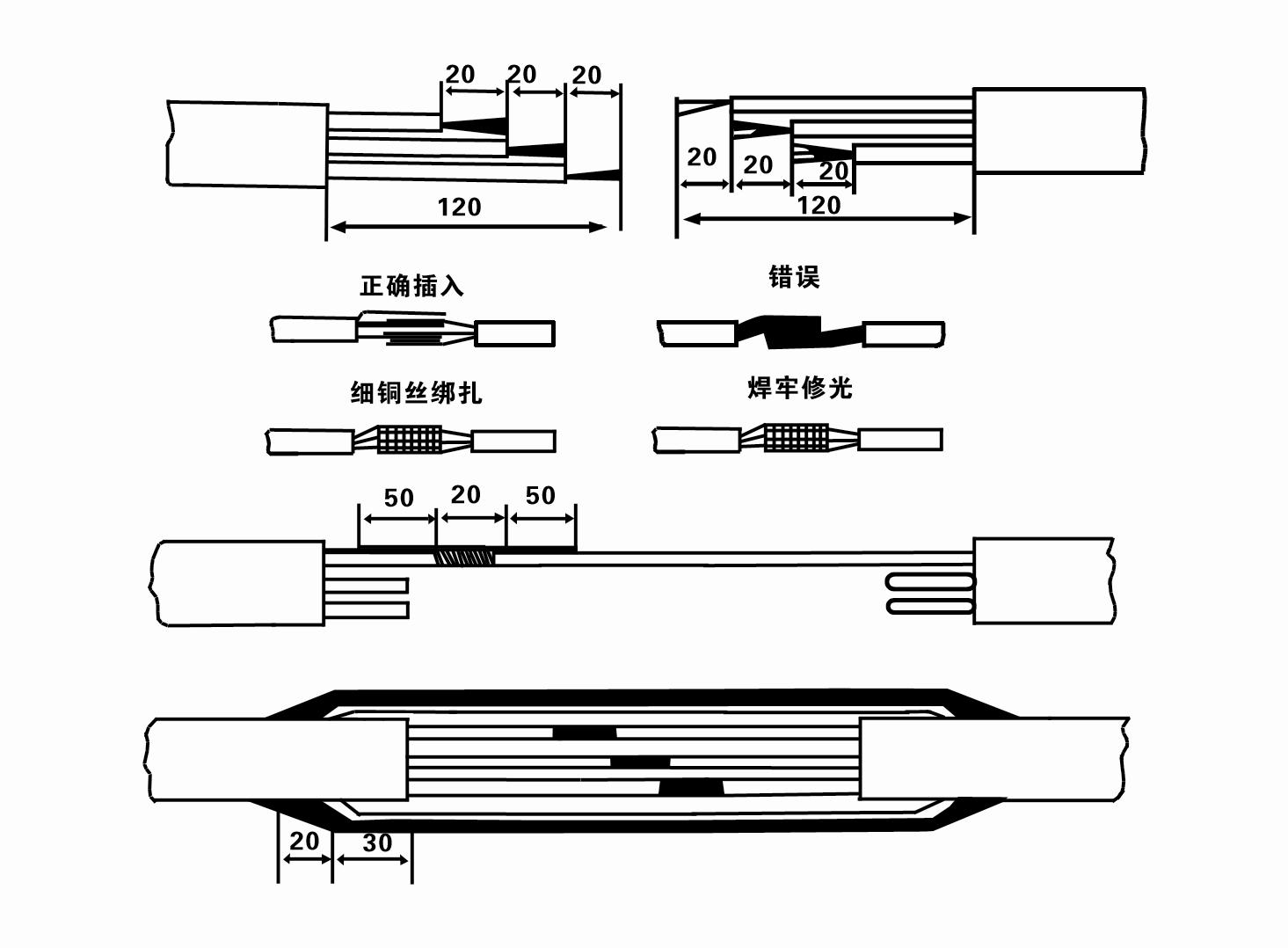
8. Za pomocą multimetru sprawdź, czy przewody trójfazowe są podłączone i czy rezystancja prądu stałego jest w przybliżeniu zrównoważona.
9. Sprawdź, czy obwód i moc transformatora nie są przeciążone, a następnie podłącz wyłącznik zabezpieczający przed przeciążeniem lub sprzęt rozruchowy. Aby zapoznać się z konkretnymi modelami, patrz Tabela 2, a następnie wlej wiadro wody do pompy wodnej z wylotu pompy wodnej, aby nasmarować gumowe łożyska pompy, a następnie umieść elektryczną pompę głębinową pionowo i stabilnie. Uruchomienie (nie dłużej niż jedna sekunda) i sprawdź, czy kierunek skrętu jest zgodny ze znakiem skrętu. Jeśli nie, zamień dowolne dwie wtyczki kabla trójfazowego. Następnie zainstaluj filtr i przygotuj się do zejścia do studni. W przypadku używania pompy elektrycznej do specjalnych celów (takich jak rowy, rowy, rzeki, stawy, stawy itp.) pompa elektryczna musi być niezawodnie uziemiona.
(2) Sprzęt i narzędzia instalacyjne:
1. Jedna para łańcuchów do podnoszenia na ponad dwie tony.
2. Statyw o wysokości pionowej nie mniejszej niż cztery metry.
3. Dwie wiszące liny (liny stalowe) o wytrzymałości większej niż jedna tona (mogą udźwignąć ciężar kompletnego zestawu pomp wodnych).
4. Zamontuj dwie pary zacisków (szyn).
5. Klucze, młotki, śrubokręty, narzędzia i przyrządy elektryczne itp.
(3) Instalacja pompy elektrycznej:
1. Schemat instalacji elektrycznej pompy głębinowej pokazano na rysunku 2. Konkretne wymiary montażowe pokazano w Tabeli 3 „Wykaz wymiarów montażowych pompy elektrycznej głębinowej”.
2. Zatapialne pompy elektryczne o wysokości podnoszenia mniejszej niż 30 metrów można wciągać bezpośrednio do studni za pomocą węży i lin stalowych lub innych lin konopnych, które są w stanie unieść cały ciężar całej maszyny, rur wodociągowych i wody w rurach.
3. W pompach o wysokości podnoszenia większej niż 30 metrów stosuje się rury stalowe, a kolejność montażu jest następująca:
①Użyj zacisku, aby zacisnąć górny koniec części pompy wodnej (silnik i pompa wodna zostały w tym czasie połączone), podnieś ją za pomocą wiszącego łańcucha i powoli przymocuj do studni, aż założysz zacisk na głowicę odwiertu i zdemontujesz wiszący łańcuch.
② Użyj kolejnej pary zacisków, aby zacisnąć rurę, podnieś ją za pomocą wiszącego łańcucha w odległości 15 cm od kołnierza i powoli opuść. Pomiędzy kołnierzem rury a kołnierzem pompy Załóż gumową podkładkę i równomiernie dokręć rurę i pompę za pomocą śrub, nakrętek i podkładek sprężystych.
③ Lekko podnieś pompę głębinową, zdejmij zacisk na górnym końcu pompy wodnej, mocno przymocuj kabel do rury wodnej za pomocą plastikowej taśmy i powoli zamocuj, aż zacisk zostanie umieszczony na głowicy odwiertu.
④Użyj tej samej metody, aby podłączyć wszystkie rury wodociągowe do studni.
⑤Po podłączeniu kabla wyjściowego do przełącznika sterującego, należy go podłączyć do trójfazowego źródła zasilania.
(4) Rzeczy, na które należy zwrócić uwagę podczas instalacji:
1. Jeśli podczas pompowania zostanie stwierdzone zjawisko zakleszczenia, obróć lub pociągnij rurę wodną, aby pokonać punkt zakleszczenia. Jeśli różne środki nadal nie pomagają, nie należy opuszczać pompy na siłę, aby uniknąć uszkodzenia elektrycznej pompy głębinowej i studni.
2. Podczas montażu należy na kołnierz każdej rury założyć podkładkę gumową i równomiernie ją dokręcić.
3. Po opuszczeniu pompy wodnej do studni należy ją umieścić na środku rury studni, aby zapobiec długotrwałemu uderzaniu pompy o ścianę studni, powodując wibrację pompy oraz zamiatanie i spalanie silnika .
4. Określ głębokość pompy wodnej do dna studni, zgodnie z warunkami przepływu piasku i mułu w studni. Nie zakopuj pompy w błocie. Odległość pompy wodnej od dna studni na ogół nie jest mniejsza niż 3 metry (patrz rysunek 2).
5. Głębokość wejścia wody do pompy wodnej nie powinna być mniejsza niż 1-1,5 metra od dynamicznego poziomu wody do węzła wlotu wody (patrz rysunek 2). W przeciwnym razie łożyska pompy wodnej mogą łatwo ulec uszkodzeniu.
6. Podnoszenie pompy wodnej nie może być zbyt niskie. W przeciwnym razie na rurociągu wody głowicy odwiertu należy zainstalować zasuwę, aby kontrolować przepływ pompy w znamionowym punkcie przepływu, aby zapobiec przeciążeniu i spaleniu silnika z powodu dużych prędkości przepływu.
7. Gdy pompa wodna pracuje, wydatek wody powinien być ciągły i równy, prąd powinien być stabilny (w znamionowych warunkach pracy, na ogół nie więcej niż 10% prądu znamionowego), nie powinno być żadnych wibracji ani hałasu. Jeśli wystąpią jakiekolwiek nieprawidłowości, należy zatrzymać maszynę, aby znaleźć przyczynę i ją wyeliminować.
8. Podczas montażu należy zwrócić uwagę na ustawienie przewodu uziemiającego silnik (patrz rysunek 2). Jeżeli rura wodna jest rurą stalową, należy ją poprowadzić od obejmy głowicy odwiertu; jeśli rura wodna jest rurą z tworzywa sztucznego, poprowadź ją od znaku uziemienia pompy elektrycznej.
After installation of the underwater pump, it is necessary to recheck the insulation resistance and three-phase continuity of the switch, and check whether the connection between the instrument and the starting equipment is wrong. If there is no problem, you can start the test machine. After starting, observe whether the indication reading of each instrument is correct. If the rated voltage and current specified on the nameplate are exceeded, observe whether the pump has any noise or vibration. If everything is normal, it can be put into operation. Four hours after the first operation of the pump, it should be turned off and the thermal insulation resistance of the motor should be quickly tested, and its value should not be less than 0.5 megaohm. After stopping the pump, it should be restarted after an interval of five minutes to prevent the water column in the pipeline from completely reversing, resulting in the motor burning due to excessive current. After the pump is put into normal operation, in order to prolong its service life, it is necessary to check regularly whether the supply voltage, working current and insulation resistance are normal. If the following conditions are found, the machine should be stopped immediately to eliminate the fault:
1 the current exceeds 20% under the rated working condition.
2 the dynamic water level drops to the inlet section, resulting in intermittent drainage.
3 the underwater pump vibrates violently or emits huge noise.
4 the supply voltage is lower than 340 volts.
5 a fuse is burned.
6 the water pipe is damaged.
7 the thermal insulation resistance of the motor to the ground is less than 0.5 megaohm.
When disassembling the device, it is necessary to untie the cable bundle and remove the pipeline part and the line protection plate. Remove the drain bolt and exclude all water in the motor chamber. Remove the filter element and loosen the screw on the coupling fixed to the motor shaft. Unscrew the bolt connecting the water inlet section and the motor, and separate the pump and the motor (pay attention to placing the device horizontally when separating to prevent the bending of the pump shaft). The sequence of disassembling the pump is as follows: (see Figure 1) water inlet section, impeller, water inlet shell, impeller. Check the valve body, and use a special tool to loosen the cone sleeve fixed to the impeller when removing the impeller. In the process of disassembly, avoid bending the pump shaft and damaging various components. The disassembly process of the motor is as follows: (see Figure 1) put the motor on the platform, and remove the nuts on the screw (pull rod bolt), base, shaft head lock nut, thrust plate, key and lower guide rail - bearing seat, bolt, and then remove the rotor (be careful not to damage the wiring harness), and finally remove the connecting parts and upper guide bearing seat. Unit assembly: before assembly, the rust and dirt of each component should be cleaned, and the sealant should be coated on each mating surface and fastener, and then assembled in the opposite order of disassembly (the movement of the motor shaft after assembly is about one millimeter), after the assembly is completed, the coupling should be flexibly rotated, and then the filter element should be placed for testing. Each time the underwater electric pump has been used for one year, or less than one year but has been immersed for two years, it must be disassembled and inspected in accordance with Article 5 and replace the worn parts.
1, wypuść wodę z komory silnika (szczególnie zimą, aby zapobiec zamarznięciu silnika) i dobrze zawiąż kabel.
2, store in an indoor room without corrosive substances and gases, with a temperature below 40 °C.
3, przy długotrwałym użytkowaniu należy zwrócić uwagę na zapobieganie rdzy pomp głębinowych.
- Wirnik
- Tuleja wału
- Gumowa tuleja wału
-
Uszczelka
01 Ujęcie wody ze studni głębinowej
02 Wysokie źródło wody
03 zaopatrzenie w wodę w górach
04 wieża wodna
05 Nawadnianie rolnictwa
06 nawadnianie ogrodu
07 ujęcie wody rzecznej
08 woda użytkowa

